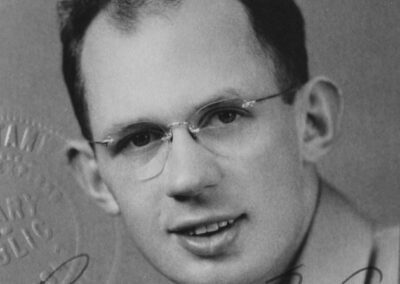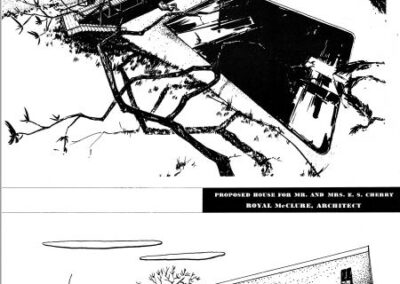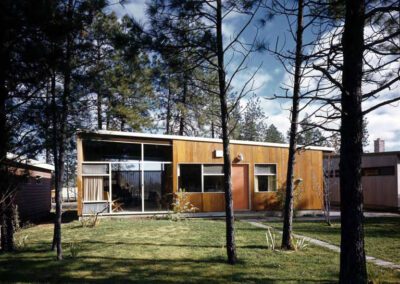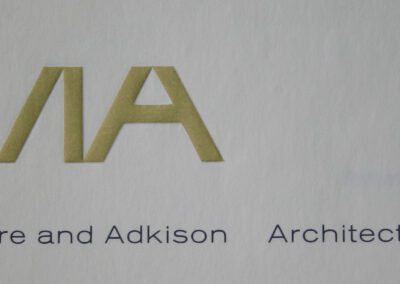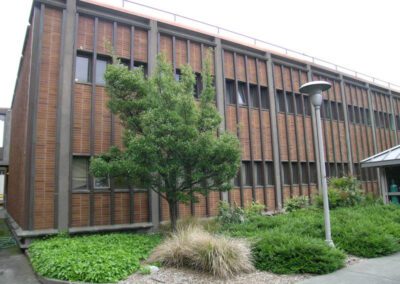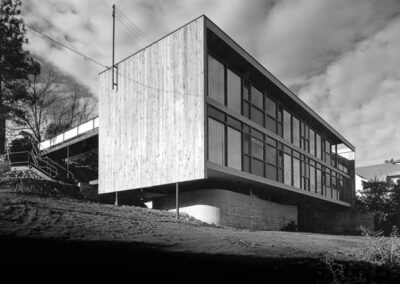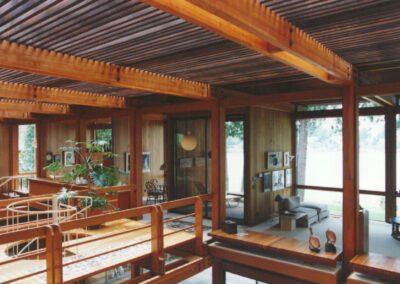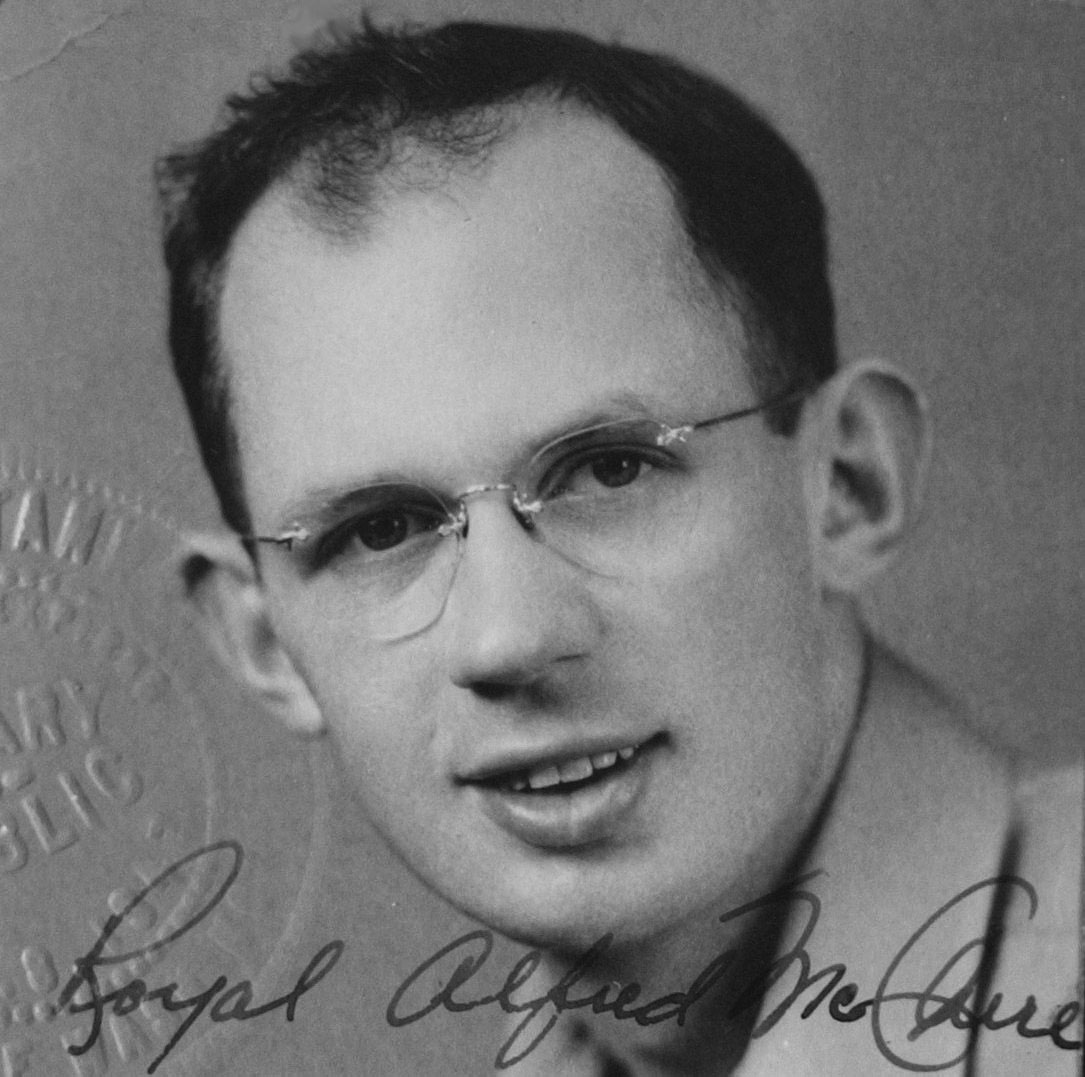
McClure, Royal A.
(1917 – 2006)
Born October 19, 1917, Royal Alfred McClure grew up in Seattle and received his Bachelor’s degree in Architecture from the University of Washington in 1942. During school, McClure worked for Seattle architect J. Lister Holmes (1891-1986). Upon graduation, he was drafted into the Army and spent most of the war as an architectural engineer in the Air Force flight program. After the war, McClure gained valuable experience by working for noted Boston architect Samuel Glaser (1945-1946), and then began to explore further educational opportunities. He was accepted to join Frank Lloyd Wright’s burgeoning architectural school at Taliesin, but decided instead to enroll in the graduate program at Harvard (1947).
Upon graduation, McClure spent a year teaching at the University of Idaho (also serving as acting Head of the Architecture Department) before opening a partnership with fellow University of Washington classmate Tom Adkison in Spokane in 1948. Together the firm of McClure & Adkison made a profound and significant impact on the built environment in the city. The firm was part of a core group of young, talented architects who brought the latest architectural fashions to the growing city of Spokane.
Early projects in Spokane included the Miesian style Studio Apartments (1949); the Stephan Dental Clinic (1950, American Institute of Architects Chapter Award); and the Cornelius House (1951). Serving as designers and developers, the firm built a group of modern dwellings on Spokane’s South Hill neighborhood in 1951. The one-block development not only served as home to McClure and Adkison and their families, but also made an architectural statement to the possibilities of modern living in the traditional community of Spokane.
Other notable projects include the Charles Decker House (1952) in Moscow, Idaho; the Davenport High School Gym (1954) in Davenport; a school in Republic (1954); Emmanuel Presbyterian Church (1957) in Spokane; the Thomas Meenach House (1959; American Institute of Architects of Spokane Award) in Spokane; and the Byrne-Ferris Machinery Company (1954) in Spokane. Around this time, McClure was recognized as an outstanding alumnus of Harvard when he received the Wheelwright Travel Fellowship for excellence in architectural practice. In 1953, he spent six months traveling in Europe with his family exploring the architectural marvels of England, France, Denmark, Switzerland, Italy, and Spain.
Several of McClure and Adkison’s projects were featured in local, regional, and national publications. Among them was McClure’s design for the E.S. Cherry House in California, published in Art & Architecture magazine in 1947. Another was their project for the Stephen Dental Clinic featured in Paul H. Kirk’s book Doctor’s Offices and Clinics (1955). Such articles brought the young architectural firm critical acclaim and, more importantly, a growing number of clients.
By 1953, former employer J. Lister Holmes had joined McClure & Adkison to form a partnership. The firm of Holmes, McClure, Adkison & McDonald, Architects & Planning Consultants, had offices in Seattle and Spokane. However, the partnership lasted for just two or three years.
By the 1960s, McClure & Adkison began to receive several high profile, substantial educational commissions. Projects included the John F. Kennedy Pavilion/Martin Centre (1965) at Gonzaga University in Spokane, a Married Housing project at Washington State University (1960) in Pullman, and Wilcox Hall and Elgin Rosco Hall at the University of Washington (1964) in Seattle. Other notable projects include Spokane Unitarian Church (1961), and Joel E. Ferris High School (1963; American Institute of Architects of Spokane Award) in Spokane. During the 1960s, the firm was also well published and was featured in a variety of magazines and shows, including the “Twenty Northwest Architects” exhibit at University of Oregon in 1962.
In 1966 McClure left the firm and moved to Seattle to open his own independent practice. His first project in Seattle was a remodel of the Equitable Savings & Loan Office (1967). Expecting more business to follow, in 1969 he formed a partnership with architect Robert J. Nixon. McClure’s most notable project, and perhaps career-defining work, was the Gil & Erselle Eade House (1969) in Hunts Point. The native fir, cedar, and hemlock house was designed on a strict, formal grid, both in plan and elevation. It featured a central, two-story atrium, which McClure referred to as a “lanai,” flanked on either side by cell-like spaces containing a traditional spread of bedrooms, kitchen, living, and bathroom areas. Other notable later projects include the Mansfield House in Laurelhurst neighborhood of Seattle, and the Asa Mercer Hall (1970) at the University of Washington, Seattle.
In 1974, the partnership was expanded by adding associate, R. Dan Farr. Together they were responsible for several structures in Alaska, many at the University of Alaska campus. In 1977, McClure retired and moved to Crane Island. Then in 1989 he and his wife moved to Maui, but they returned to Seattle in 1995 living on Anderson Island. He passed away there on September 16, 2006.
– Michael C Houser
Royal A. McClure Residence | Spokane
Built 1951 | Source: University of Washington Special Collections
Wilcox Hall – University of Washington | Seattle
Built 1963 | Source: University of Washington Special Collections
